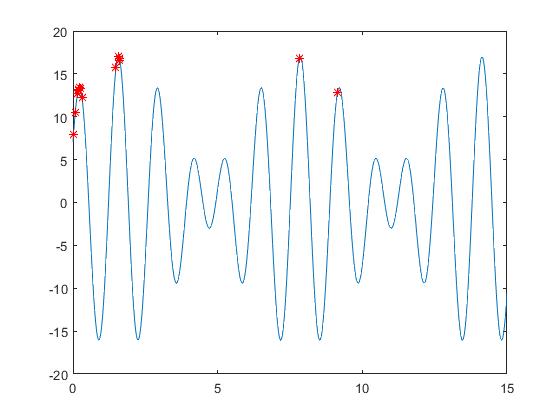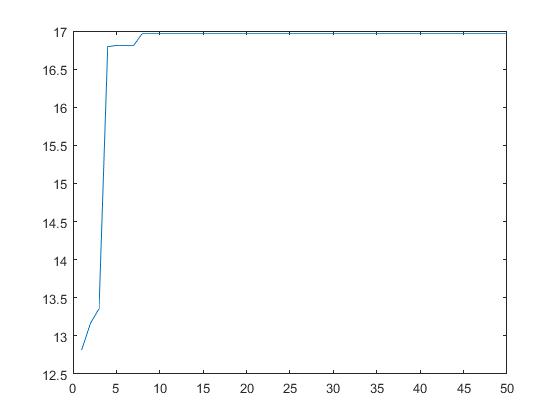Concepts of inheritance:
- Genetic algorithm is a computational model that simulates the natural selection and genetic mechanism of Darwin's biological evolution theory. It is a method to search for the best solution by simulating the natural evolution process.
The characteristics of genetic algorithms:
- Common features of search algorithms are
- First, a set of candidate solutions is formed.
- The applicability of these candidate solutions is calculated based on some usability conditions.
- Some candidate solutions are retained according to fitness, while others are discarded.
- Some operations are performed on the reserved candidate solution to form a new one.
- Because genetic algorithm is one of the search algorithms, it has the above characteristics. In addition, genetic algorithm has its own unique features:
- The genetic algorithm starts with a bundle of solutions (multiple candidate solutions) rather than a single solution, which is the biggest difference from traditional optimization algorithms.
- Genetic algorithm handles multiple individuals in a group at the same time, which facilitates parallel settlement
- Genetic algorithm has basically different search space, which makes it more widely used.
- The genetic algorithm does not use deterministic rules, but uses probability transition rules to guide its search direction.
Terminology in genetic algorithms
- Chromosomes: Chromosomes are genotypic individuals. A certain number of individuals make up a population. The number in a population is called Population size.
- Genes: Genes are elements in a string. Genes are used to represent individual characteristics, such as a string S=1011. Four of these elements, 1, 0, 1, 1, are called genes. Their values are called alleles.
- Locus: A locus is the position of a gene in a string.
- Feature: The characteristic value of a gene is the same as the binary weight.
- Fitness: Individuals'fitness to the environment is called fitness, and fitness functions are used to quantify fitness.
Principles of genetic algorithms
- Genetic algorithm flowchart
- Selection: Selecting the winner and eliminating the inferior is called selection, which is based on the evaluation of individual fitness. The methods include roulette selection, random traversal sampling and local selection. For roulette selection, the probability of each individual being selected is proportional to the fitness, that is: p i = f i ∑ j = 1 n f i \color{blue}{p_i=\frac{f_i}{\sum_{j=1}^{n}f_i}} pi =j=1n fi. After calculating the individual selection probability, in order to mate an individual, multiple rounds of selection are needed, each of which produces a uniform random number between [0,1] the most selection pointer to determine the selected individual. Once selected, individuals can randomly form mating pairs.
- Crossing: The so-called crossover is the operation of replacing part of the structure of two parent individuals to produce a new individual. The crossover algorithm is
- real valued recombination
- Binary crossover
The most common is the single intersection in binary intersection, which randomly calls parts of the structure before or after an intersection in two individual strings to produce two new individuals.
- Variation: Variation is the random selection of one or more loci according to the rate of variation and the reversal of these loci. The rate of variation is usually low, ranging from 0.001 to 0.1.
- Termination condition: When the fitness of the best individual reaches a given threshold, or when the fitness of the best individual and the fitness of the population do not rise, or when the number of iterations reaches a preset number, the algorithm terminates. Generally, the preset algebra is 100-500 generations.
- Selection of fitness function
The fitness function should be designed to meet the following conditions- Single value, continuous, non-negative, maximize
- Reasonable and consistent
- Small computation
- Strong versatility
- Selection of Initial Group
The initial population is randomly generated.
Programming
For example, finding a function f ( x ) = 10 ∗ s i n ( 5 x ) + 7 ∗ c o s ( 4 x ) , x ∈ [ 0 , 10 ] \color{blue}{f(x)=10*sin(5x)+7*cos(4x),x\in[0,10]} f(x)=10_sin(5x)+7_cos(4x),x<[0,10]max
- Solution:
- Initialization:
function pop = initpop( popsize, chromlength ) pop=round(rand(popsize,chromlength)); %rand Random generation of 0 for each element~1 Decimals between, rows popsize,Number of columns chromlength Matrix of% %round Round each element of the matrix so that the result is 0 or 1% end- Target Function Value
%Convert binary to decimal% function pop2 = decodebinary(pop ) [rows,cols] = size(pop);%seek pop Number of rows and columns% for i=1:cols pop1(:,i)=2.^(cols-i).*pop(:,i); end pop2=sum(pop1,2);%seek pop1 Sum of each line% end%Its function is to convert chromosomal or binary encoding to decimal %Where parameters spoint Represents the starting position of a binary string with decoding %length Represents the length of the intercept function pop2= decodechrom(pop,spoint,length) pop1=pop(:,spoint:spoint+length-1); pop2=decodebinary(pop1); end%Its function is to calculate the value of the objective function function [objvalue] = calobjvalue(pop,length) temp=decodechrom(pop,1,length);%take pop Convert each row to a decimal number x=temp*10/(power(2,length)-1);%Converts the number in the binary field of each row to the number in the variable field objvalue=10*sin(5*x)+7*cos(4*x);%Calculate the value of the objective function end
- Fitness value
%Calculate an individual's fitness function fitValue= calfitvalue( objValue) fitValue=objValue+100;%Design the fitness calculation function according to the situation end - Cross operation
%Crossover operation function function [ newpop] = crossover(pop,pc) [rows,cols]=size(pop); newpop=zeros(2*rows,cols); index=1; for i=1:rows other=i; if(rand<pc) %Each individual has the same probability of being selected to perform crossover while other==i other=1+floor(rand*rows);%Randomly select a crossover object end cpoint=floor(rand*cols)+1;%Randomly select an intersection %Execution Crossing newpop(i,:)=[pop(i,1:cpoint),pop(other,cpoint+1:cols)]; newpop(rows+index,:)=[pop(other,1:cpoint),pop(i,cpoint+1:cols)]; index=index+1; else newpop(i,:)=pop(i,:); end end newpop=newpop(1:rows+index-1,:);%Since the number of initialized rows is 2*rows,But the actual number of rows assigned is index-1 That's ok. end - Variation operation
%Variation operation function newpop = mutation( pop,pm) [rows,cols]=size(pop); newpop=ones(size(pop)); for i=1:rows newpop(i,:)=pop(i,:); if rand<pm%If the random number is less than the mutation probability, select a mutation point to mutate this chromosome mpoint=round(rand*cols);%Random Selection of Variation Points if mpoint<=0%Prevent mutation from generating 0 mpoint=1; end if newpop(i,mpoint)==0%If the original point of variation is 0 then the variation is 1, otherwise the variation is 0. newpop(i,mpoint)=1; else newpop(i,mpoint)=0; end end end end - Select the next generation of individuals
%Choice N The principle of screening is that individuals with higher suitability have a higher probability of being selected when they enter the next generation. function newPop = selection(pop,fitValue,N ) totalFit=sum(fitValue); fitValue=fitValue/totalFit;%Probability of an individual being selected fitValue=cumsum(fitValue);%The sum of all the preceding elements of the corresponding element in the input for each element in the output [rows,cols]=size(pop); newPop=zeros(N,cols); isSelected=zeros(1,rows);%Is the record selected newin=1; while newin<N p=rand; for i=1:rows if ((isSelected(1,i)==0) && (p<=fitValue(i))) isSelected(1,i)=1; newin=newin+1; newPop(newin,:)=pop(i,:); break; end end end end - Record the most adaptable individuals
%In this iteration, select the individuals with the highest fitness and their values function [bestIndividual,bestValue] = best( pop,fitValue,objValue) [rows,cols]=size(pop); bestIndividual=pop(1,:); bestFit=fitValue(1); for i=2:rows if fitValue(i)>bestFit bestIndividual=pop(i,:); bestFit=fitValue(i); bestValue=objValue(i); end end end - Principal function
function []= main( ) clear; popSize=20;%Population Number chromLength=10;%Chromosome Length pc=0.7;%Crossover probability pm=0.005;%Probability of Variation iterators=200;%Number of iterations pop=initpop(popSize,chromLength);%Initialize Population y=zeros(1,iterators); x=zeros(1,iterators); maxValue=zeros(1,iterators);%Record the maximum value for each iteration for i=1:iterators newPop=crossover(pop,pc);%overlapping newPop=mutation(newPop,pm);%variation objValue=calobjvalue(newPop,chromLength);%Calculating individual objective function values fitValue=calfitvalue(objValue);%Calculate Individual Fitness [bestIndividual,bestValue]=best(newPop,fitValue,objValue);%Select the Individual with the Highest Fitness y(i)=bestValue; maxValue(1,i)=max(y);%Each iteration records the highest fitness individual value in this iteration x(i)=decodechrom(bestIndividual,1,chromLength)*10/1023;%Record the values in the variable domain of the most adaptable individual in this iteration pop=selection(newPop,fitValue,popSize);%Selecting Next Generation Individuals end fplot('10*sin(5*x)+7*cos(4*x)',[0,15]); hold on; plot(x,y,'r *'); hold off; plot(maxValue); end - Run Results
- The position of the maximum value of each iteration in the original function image

Since the maximum value for each iteration is not necessarily greater than the maximum value for the previous iteration, there will be some duplication of values in the vector that records the maximum value. - Maximum change per iteration

You can see that as the number of iterations increases, it quickly converges near the maximum.
- The position of the maximum value of each iteration in the original function image